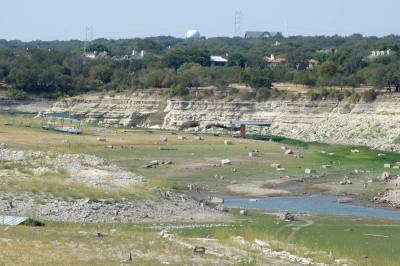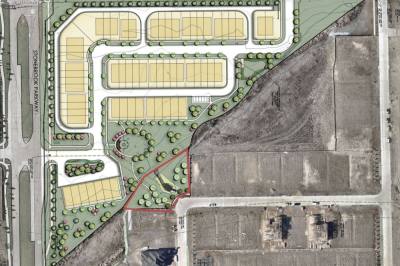Austin is loved for its natural resources, but drought and climate change are an ongoing threat to the city’s water supply—and the worst may still be on the horizon. However, Austin Water has a proactive, century-long plan that is constantly being developed and implemented to help find solutions for the future.
Marisa Flores Gonzales is the Water Resources Team Supervisor in the Systems Planning Division at Austin Water. Her team develops and updates Water Forward, Austin Water’s 100-year integrated water resource plan, and implements its strategies.
“Austin is a growing city. It’s a city that has experienced the impacts of drought in the past and will continue to experience future droughts,” Gonzalez said. “We’re experiencing the impacts of climate change as well. So, we need to plan for things like population growth, drought, climate change and the kind of impacts that those will have on our water supplies.”
The Water Forward plan includes four strategies: drought supplies, protecting water supplies, reusing water and conserving water. One of the main projects Gonzales and her team are working on is aquifer storage and recovery, which includes the onset of an aquifer storage and recovery pilot project.
“Once we identify a location for the pilot, by around 2024 from 2027, they’d be actually piloting that strategy and constructing potentially a full scale ASR facility,” Gonzalez said. “We want to have water withdrawal by 2040, so that if future droughts—worse than the droughts that we’ve experienced in the past—happen, we’ll be prepared for those. That will allow us to kind of stretch our water supplies and meet our community’s water needs.”
Austin’s source of water comes from the Colorado River and the Highland Lakes. The city has a combination of state granted water rights to water that flows through each source. If supply from the Colorado River does not meet demands, the Highland Lakes are used as a backup.
“In a project like ASR, that’s creating yet another backup supply of water. So, we kind of have a backup for our backup,” Gonzalez said. “It’s another insurance policy to make sure that we have enough water even during droughts that might be more severe in the future—and the great thing about ASR is that we can withdraw water from our existing water rights and take that water, store it underground, and then withdraw it during drought periods.”
Reuse and conservation are also vital components of Water Forward. Storm water, rainwater and greywater harvesting, as well as black water reuse, are key in ensuring available water is being fit to the best use and stretched as much as possible.
Gonzalez said another pilot program her team has built and incorporated into the city’s new permitting and development center is a combination of a rainwater harvesting system and an on-site black water reuse system.
“The on-site black water reuse system collects all of the wastewater that’s produced within that city facility and then treats it on-site in a small facility that’s tucked underneath a walkway between a building and parking garage,” Gonzalez said. “Then, you’re able to use that water for toilet flushing and outdoor irrigation. It’s like a closed loop type of cycle ... it’s going into the toilet and then back into that facility.”
The Water Forward Plan was approved by Austin City Council in 2018, and the new one will be adopted in 2024. Its creation was sparked by the 2008-2016 drought, during which inflows of water and storage volumes in Lake Travis and Lake Buchanan were at all-time lows. It is an adaptive plan that will be updated on a five-year cycle as evaluation and planning for water supply evolve.
“We’re able to take into account changing conditions and new information. We update our projections on population growth and water demand to take into account what growth has happened in the past,” Gonzalez said. “We’re able to take a really good look at what has worked, what might need improvement and what might need adjustment.”
Another factor taken into account are community needs. For the 2024 Water Forward
plan, Austin Water staff are working on creating an equity and affordability roadmap that will help evaluate those types of considerations in plan recommendations and make adjustments as necessary.
“It’s another opportunity for us to refresh on ‘What does our company value? What’s important to our community? What’s affecting our community at this point in time?’”Gonzalez said.
Austin Water has an ongoing council-appointed task force, the Austin Integrated Water Resource Planning Community Task Force, that meets every two months with citizen communication as a part of the public meetings. Updates are given on the implementation of the current plan and the development of the 2024 plan.
Aside from participating with community feedback, Austin residents can support the 100-year plan with responsible use of water supplies. Tips from Gonzalez include one day per week watering schedules for residents with lawns, making sure that irrigation systems are efficient, identifying potential leaks, and using high efficiency fixtures.
“Austinities love water, we love the Colorado River, we love the Highland Lakes and we love to be outside. We cherish these natural spaces,” Gonzalez said. “It’s making that connection between ‘these are natural spaces’ and ‘this is also our water supplies.’ We just have to be really attune to that fact and make sure we’re using water supplies as responsibly as we can.”
Learn more about Water Forward at www.austintexas.gov/department/water-forward and receive Water Forward updates by signing up for its newsletter here.
The above story was produced by Community Impact's Storytelling team with information solely provided by the local business as part of their "sponsored content" purchase through our advertising team. Our integrity promise to our readers is to clearly identify all CI Storytelling posts so they are separate from the content decided upon, researched and written by our journalism department.
Select your community
Support Us
News
- Austin Metro
-
Houston Metro
- Houston Metro Home
- Bay Area
- Bellaire | Meyerland | West University
- Conroe | Montgomery
- Cy-Fair | Jersey Village
- Cypress
- Heights | River Oaks | Montrose
- Katy | Fulshear
- Lake Houston | Humble | Kingwood
- New Caney | Porter
- Pearland | Friendswood | Manvel
- Spring | Klein
- Sugar Land | Missouri City
- The Woodlands
- Tomball | Magnolia
- Dallas | Fort Worth Metro
- San Antonio Metro










